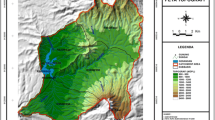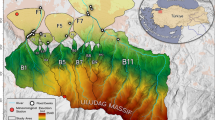Abstract
Hydraulic engineerings built on tributaries at the confluence of main and branch streams are significant to river management and runoff regulation. The Flood Control Design Level (FCDL) calculations for these works are directly influenced by tributary floods and supporting effects from the mainstream. However, the determination of design level under main and tributary floods has not been well investigated. To address this issue, the authors proposed a Copula-based approach to analyze the design level under multiple runoff discharge with a case study of the Gui** Ship** Hub(GPSH). The proposed method is compared with the conventional multivariate hydrological elements analysis approach, and the sampling uncertainty is also studied. The results showed that the joint distribution of main and tributary floods is well modeled by Clayton Copula, with PE3s as the best-fit marginal distributions. Furthermore, the different roles of main and branch fluxes in design level calculation can be identified by the offered Flood Control return period(FCRP). And the design levels conducted by the FCRP can avoid the situation over-or-under performed by the OR or AND RP. Moreover, flood combinations uncertainty analysis indicates that the uncertainty of the joint design combinations decreases with the increase of sample size n but increases with the rise of the design T. Finally, the 95% confidence interval and standard deviation of the design level calculated by FCRP are smaller than that of OR RP, which means the FCRP can reduce uncertainty under multiple floods. These results suggest that the proposed FCRP provides an appropriate approach for determining the design level under combined fluxes and serves as a reference for engineering practice.







Similar content being viewed by others
Data Availability
The hydrological time-series data used to support the findings of this study are available from the corresponding author upon reasonable request.
References
Abdi A, Hassanzadeh Y, Talatahari S, Fakheri-Fard A, Mirabbasi R (2016) Regional bivariate modeling of droughts using l-comments and copulas. Stoch Env Res Risk A 1–12
Alila Y, Mtiraoui A (2002) Implications of heterogeneous flood-frequency distributions on traditional stream-discharge prediction techniques. Hydrol Process 16(5):1065–1084
Brahimi B, Chebana F, Necir A (2011) Copula representation of bivariate L-moments: A new estimation method for multiparameter 2-dimensional copula models. SSRN Electr J 49(1–3):497–521
Dodangeh E, Singh VP, Pham BT, Yin J, Yang G, Mosavi A (2020) Flood frequency analysis of interconnected rivers by copulas. Water Resour Manag 34(11):3533–3549
Duan K, Mei YD, Zhang LP (2016) Copula-based bivariate flood frequency analysis in a changing climate-A case study in the Huai River Basin, China. J Earth Sci
Fang HB, Fang KT, Kotz S (2002) The meta-elliptical distributions with given marginals. J Multivariate Anal 82(1):1–16
Favre AC, El Adlouni S, Perreault L, Thiémonge N, Bobée B (2004) Multivariate hydrological frequency analysis using copulas. Water Resour Res 40(1):1–12
Li TY, Guo SL, Yan BW, Chen L (2013a) Derivative design flood hydrograph based on trivariate joint distribution. J Hydroelectric Eng 32(3):10–14,38. (in Chinese)
Li TY, Guo SL, Chen L, Guo JL (2013b) Bivariate flood frequency analysis with historical information based on Copula. J Hydrol Eng 18(8):1018–1030
Lian JJ, Xu K, Ma C (2013) Joint impact of rainfall and tidal level on flood risk in a coastal city with a complex river network: a case study of Fuzhou City, China. Hydrol Earth Syst Sc 17(2). (2013–02–14), 17(1):679–689
Liu Q, Hu D, Yan Q (2010) Decision tree algorithm based on average Euclidean distance. Int Conf Future Comput Commun IEEE, pp 507–51
Mirakbari M, Ganji A, Fallah SR (2010) Regional bivariate frequency analysis of meteorological droughts. J Hydrol Eng 15(12):985–1000
Modarres R (2008) Regional frequency distribution type of low flow in north of Iran by L-moments. Water Resour Manag 22:823–841
Mou SY, Shi P, Qu SM, Ji XM, Zhao LL, Feng Y, Chen C, Dong FC (2018) Uncertainty analysis of two copula-based conditional regional design flood composition methods: a case study of Huai River, China. Water 10(12)
Nelsen RB (2000) An Introduction to Copulas. Technometrics 42(3)
Peng Y, Yu XL, Yan HX, Zhang JP (2020) Stochastic simulation of daily suspended sediment concentration using multivariate copulas. Water Resour Manag 34(12):3913–3932
Pham-Gia T, Hung TL (2001) The mean and median absolute deviations. Math Comput Model 34(7):921–936
Plackett RL (1965) A class of bivariate distributions. J Am Stat Assoc 60(310):516–522
Rad AM, Ghahraman B, Khalili D, Ghahremani Z, Ardakani SA (2017) Integrated meteorological and hydrological drought model: a management tool for proactive water resources planning of semi-arid regions. Adv Water Resour 107(Sep.):336–353
Ren WN, Deng XY, Feng P (2016) Design flood recalculation under land surface change. Nat Hazards
Salvadori G, Michele CD (2004) Frequency analysis via copulas: theoretical aspects and applications to hydrological events. Water Resour Res 40(12)
Salvadori G, Michele CD, Durante F (2011) On the return period and design in a multivariate framework. Hydrol Earth Syst Sci 15(11):3293–3305
Serinaldif F (2013) An uncertain journey around the tails of multivariate hydrological distributions. Water Resour Res 49(10):6527–6547
Shiau JT, Modarres R (2009) Copula-based drought severity-duration-frequency analysis in Iran. Meteorol Appl 16(4):481–489
Shojaeezadeh SA, Nikoo MR, McNamara JP, AghaKouchak A, Sadegh M (2018) Stochastic modeling of suspended sediment load in alluvial rivers. Adv Water Resour 119:188–196
Sklar A (1959) Fonctions de répartition àn dimensions at leurs marges. Publ Inst Statis, Univ Paris-VIII 8:229–231
Sraj M, Bezak N, Brilly M (2015) Bivariate flood frequency analysis using the copula function: a case study of the litija station on the Sava river. Hydrol Process 29(2):225–238
Tsakiris G, Kordalis N, Tsakiris V (2015) Flood double frequency analysis: 2D-Archimedean copulas vs bivariate probability distributions. Environ Process 2:705–716
Tu XJ, Du YL, Singh VP, Chen XH (2018) Joint distribution of design precipitation and tide and impact of sampling in a coastal area. Int J Climatol
Xu K, Ma C, Lian JJ, Bin LL (2014) Joint probability analysis of extreme precipitation and storm tide in a coastal city under changing environment. Plos One 9(10)
Xu K, Yang DW, Xu XY, Lei HM (2015) Copula-based drought frequency analysis considering the Spatio-temporal variability in southwest china. J Hydrol 527:630–640
Yin JB, Guo SL, Liu ZJ, Yang Guang, Zhong YX, Liu DD (2018) Uncertainty analysis of bivariate design flood estimation and its impacts on reservoir routing. Water Resour Manage: An International Journal, Published for the European Water Resources Association (EWRA) 32(5):1795–1809
Zhang L, Singh VP (2007a) Bivariate rainfall frequency distributions using archimedean copulas. J Hydrol 332(1–2):93–109
Zhang L, Singh VP (2007b) Trivariate flood frequency analysis using the Gumbel-Hougaard Copula. Jhydrol Eng 12(4):431–439
Acknowledgements
We are grateful for the support received as part of the projects funded by the National Natural Science Foundation of China (Grant Numbers, 41807197), the Natural Science Foundation of Guangxi (Grant Numbers, 2018GXNSFAA138042), and the Innovation Team Project of Estuarine and Coastal Protection and Management (Grant Numbers, Y220013).
Funding
This research was partly supported by the National Natural Science Foundation of China (Grant Numbers, 41807197), the Natural Science Foundation of Guangxi (Grant Numbers, 2018GXNSFAA138042), and the Innovation Team Project of Estuarine and Coastal Protection and Management (Grant Numbers, Y220013).
Author information
Authors and Affiliations
Contributions
All authors contributed to the study's conception and design. Material preparation, data collection, and analysis were performed by Y.M. Huang, Y.J. Li, M. L, L. **ao, F.W. Gan, J. Jiao. This revised version of the manuscript was written by Y.M. Huang, and reviewed by L. **ao, F.W. Gan, J. Jiao. All authors read and approved the final manuscript.
Corresponding author
Ethics declarations
Consent to Participate
The authors declare that they consent to participate.
Consent to Publish
The authors declare that they consent to publish.
Conflict of Interest
The authors declare that they have no conflicts of interest in this work.
Additional information
Publisher's Note
Springer Nature remains neutral with regard to jurisdictional claims in published maps and institutional affiliations.
Rights and permissions
About this article
Cite this article
Huang, Y., Li, Y., Liu, M. et al. Uncertainty Analysis of Flood Control Design Under Multiple Floods. Water Resour Manage 36, 1175–1189 (2022). https://doi.org/10.1007/s11269-022-03066-8
Received:
Accepted:
Published:
Issue Date:
DOI: https://doi.org/10.1007/s11269-022-03066-8




